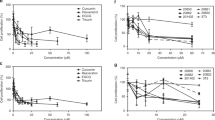Abstract
EGCG [(-)-epigallocatechin-3-gallate] has shown its antitumor ability and perhaps a potential regimen for cancer patients. The goal of this study was to investigate the effect of EGCG on human papilloma virus (HPV) positive cervical cancer cell lines. EGCG inhibited the growth of CaSki (HPV16 positive) and HeLa (HPV18 positive) cells in a time- and concentration-dependent manner. Cell cycle arrest and apoptosis were observed in two cell lines after EGCG exposure. More importantly, we focused on EGCG regulation ability on pivotal genes involved in cervical cancer: viral oncogenes E6/E7, estrogen receptor (ER) and aromatase. Our results suggested that EGCG may be suitable for prevention and treatment of cervical cancer.
Similar content being viewed by others
References
Ahn, W. S., Yoo, J., Huh, S. W., Kim, C. K., Lee, J. M., Namkoong, S. E., Bae, S. M., and Lee, I. P., Protective effects of green tea extracts (polyphenon E and EGCG) on human cervical lesions. Eur. J. Cancer Prev., 12, 383–90 (2003).
Bardin, A., Hoffmann, P., Boulle, N., Katsaros, D., Vignon, F., Pujol, P., and Lazennec, G., Involvement of estrogen receptor beta in ovarian carcinogenesis. Cancer Res., 64, 5861–5869 (2004).
Deligeoroglou, E., Michailidis, E., and Creatsas, G., Oral contraceptives and reproductive system cancer. Ann. N. Y. Acad. Sci., 997, 199–208 (2003).
Elson, D. A., Riley, R. R., Lacey, A., Thordarson, G., Talamantes, F. J., and Arbeit, J. M., Sensitivity of the cervical transformation zone to estrogen-induced squamous carcinogenesis. Cancer Res., 60, 1267–1275 (2000).
Hsu, S., Bollag, W. B., Lewis, J., Huang, Q., Singh, B., Sharawy, M., Yamamoto, T., and Schuster, G., Green tea polyphenols induce differentiation and proliferation in epidermal keratinocytes. J. Pharmacol. Exp. Ther., 306, 29–34 (2003).
Huh, S. W., Bae, S. M., Kim, Y.-W., Lee, J. M., Namkoong, S. E., Lee, I. P., Kim, S. H., Kim, C. K., and Ahn, W. S., Anticancer effects of (-)-epigallocatechin-3-gallate on ovarian carcinoma cell lines. Gynecol. Oncol., 94, 760–768 (2004).
Kim, S., Lee, M. J., Hong, J., Li, C., Smith, T. J., Yang, G. Y., Seril, D. N., and Yang, C. S., Plasma and tissue levels of tea catechins in rats and mice during chronic consumption of green tea polyphenols. Nutr. Cancer, 37, 41–48 (2000).
Kim, S. Y., Kim, D. S., Kwon, S. B., Park, E. S., Huh, C. H., Youn, S. W., Kim, S. W., and Park, K. C., Protective effects of EGCG on UVB-induced damage in living skin equivalents. Arch. Pharm. Res., 28, 784–790 (2005).
Livak, K. J. and Schmittgen, T. D., Analysis of relative gene expression data using real-time quantitative PCR and the 2(-Delta Delta C(T)) Method. Methods (San Diego, Calif ), 25, 402–408 (2001).
Mantovani, F. and Banks, L., The human papillomavirus E6 protein and its contribution to malignant progression. Oncogene, 20, 7874–7887 (2001).
Moodley, M., Sewart, S., Herrington, C. S., Chetty, R., Pegoraro, R., and Moodley, J., The interaction between steroid hormones, human papillomavirus type 16, E6 oncogene expression, and cervical cancer. Int. J. Gynecol. Cancer, 13, 834–842 (2003).
Mukhtar, H. and Ahmad, N., Tea polyphenols: prevention of cancer and optimizing health. Am. J. Clin. Nutr., 71, 1698S–702S; discussion 1703S–1704S (2000).
Munger, K. and Howley, P. M., Human papillomavirus immortalization and transformation functions. Virus. Res., 89, 213–228 (2002).
Munoz, N., Bosch, F. X., De Sanjose, S., Herrero, R., Castellsague, X., Shah, K. V., Snijders, P. J., and Meijer, C. J., Epidemiologic classification of human papillomavirus types associated with cervical cancer. N. Engl. J. Med., 348, 518–527 (2003).
Nair, H. B., Luthra, R., Kirma, N., Liu, Y. G., Flowers, L., Evans, D., and Tekmal, R. R., Induction of aromatase expression in cervical carcinomas: effects of endogenous estrogen on cervical cancer cell proliferation. Cancer Res., 65, 11164–11173 (2005).
O’donnell, A. J., Macleod, K. G., Burns, D. J., Smyth, J. F., and Langdon, S. P., Estrogen receptor-alpha mediates gene expression changes and growth response in ovarian cancer cells exposed to estrogen. Endocr. Relat. Cancer, 12, 851–866 (2005).
Opare Kennedy, D., Kojima, A., Hasuma, T., Yano, Y., Otani, S., and Matsui-Yuasa, I., Growth inhibitory effect of green tea extract and (-)-epigallocatechin in Ehrlich ascites tumor cells involves a cellular thiol-dependent activation of mitogenic-activated protein kinases. Chem. Biol. Interact., 134, 113–133 (2001).
Scheffner, M. and Whitaker, N. J., Human papillomavirus-induced carcinogenesis and the ubiquitin-proteasome system. Semin. Cancer Biol., 13, 59–67 (2003).
Stratton, S. P., Bangert, J. L., Alberts, D. S., and Dorr, R. T., Dermal toxicity of topical (-)epigallocatechin-3-gallate in BALB/c and SKH1 mice. Cancer Letters, 158, 47–52 (2000).
Walboomers, J. M., Jacobs, M. V., Manos, M. M., Bosch, F. X., Kummer, J. A., Shah, K. V., Snijders, P. J., Peto, J., Meijer, C. J., and Munoz, N., Human papillomavirus is a necessary cause of invasive cervical cancer worldwide. J. Pathol., 189, 12–19 (1999).
Yang, C. S., Maliakal, P., and Meng, X., Inhibition of carcinogenesis by tea. Annu. Rev. Pharmacol. Toxicol., 42, 25–54 (2002).
Yokoyama, M., Noguchi, M., Nakao, Y., Pater, A., and Iwasaka, T., The tea polyphenol, (-)-epigallocatechin gallate effects on growth, apoptosis, and telomerase activity in cervical cell lines. Gynecol. Oncol., 92, 197–204 (2004).
Author information
Authors and Affiliations
Corresponding author
Rights and permissions
About this article
Cite this article
Qiao, Y., Cao, J., Xie, L. et al. Cell growth inhibition and gene expression regulation by (-)-epigallocatechin-3-gallate in human cervical cancer cells. Arch. Pharm. Res. 32, 1309–1315 (2009). https://doi.org/10.1007/s12272-009-1917-3
Received:
Revised:
Accepted:
Published:
Issue Date:
DOI: https://doi.org/10.1007/s12272-009-1917-3




